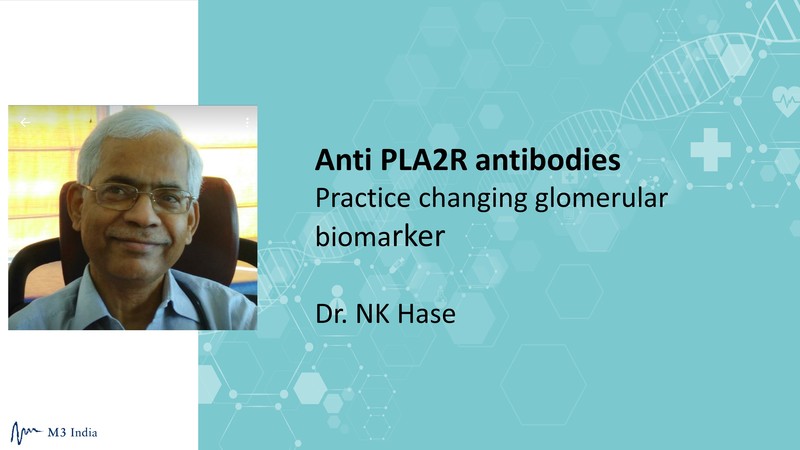Anti PLA2R antibodies: Practice changing glomerular biomarker : Dr. NK Hase
M3 India newsdesk Sep 23, 2019
Dr. N K Hase, a noted Nephrologist, shares a review that addresses key points about PLA2R antibodies;a bio marker that has changed nephrologists' practise; the way they diagnose, treat and prognosticate the membranous nephropathy.

Kidney biopsy is the gold standard for diagnosis of glomerular diseases. It also gives idea about aetiology prognosis and help to decide therapy. The kidney biopsy is invasive and associated with risk of bleeding. In some cases kidney biopsy gives idea only about injury pattern like focal segmental glomerular sclerosis, membrano proliferative pattern and may not give accurate aetiology. There may also be sampling errors.
Thus biomarkers have been used to detect disease early and improve diagnosis more accurately, predict prognosis as well as to to decide and monitor the therapy.
A biomarker is defined as “a characteristic that is objectively measured and evaluated as an indicator of normal biological process, pathologic process or pharmacologic response to therapeutic interventions."
The discovery of new biomarker anti M type Phospholipase A2 receptor (PLA2R) auto antibodies has revolutionised the field of membranous nephropathy. This is one of the commonest glomerular disease occurring in adult. Anti PLA2R antibodies detected in serum of membranous nephropathy have characteristic of an ideal biomarker- non invasive, easily measured, provide rapid results, high sensitivity ,high specificity, diagnose the disease, prognosticate the disease, helps to decide and monitor therapy and provide information about the mechanism of disease.
The availability of this biomarker PLA2R has changed our practise; the way we diagnose, treat and prognosticate the membranous nephropathy.
This review will address key points about PLA2R antibodies.
In 2009 Laurence H Beck, Jean M Francis and David Slant et al reported PLA2R as major target antigen in primary membranous nephropathy (PMN). PLA2R is expressed on cell body and foot processes of human podocytes. When PLA2R antibodies bind the antigen, immune complexes (IC) are formed and then these aggregates of IC shed into sub epithelial space between podocytes and basement membrane, this leads to complement activation podocytes damage and results in proteinuria. What triggers the antibody production is not known, PLA2R antibody is predominantly IgG4 subclass. Detection of PLA2R by immune staining along the capillary wall is very sensitive and specific to diagnose PMN.
The original discovery of anti PLA2R antibody and early clinical studies used western blotting technique for detection. Western blotting using recombinant human PLA2R antigen is very sensitive and specific for detection of anti PLA2R antibodies in serum but technique is costly, labour intensive and not practical for routine clinical use.
Currently available- two tests indirect immmunoflouroscence assay (IIFA) and enzyme linked immune-sorbent (ELISA) are approved by both US FDA and European medicine agency. Compared with western blot assay for anti PLA2R both IIFA and ELISA test are highly specific for PMN versus secondary MN and other form of glomerular diseases. ELISA is commonly used technique for detection of PLA2R Ab levels, it also provides quantitative value.
Anti PLA2R antibodies has proved to be valuable marker for diagnosis of PMN. Their specificity is more than 95% and sensitivity between 75-80%. It is important to note that 2/3 of the patients with hepatitis B, hepatitis C or sarcoidosis associated membranous nephropathy showed anti PLA2R positivity. Immmunoflouroscence uses an antibody for the antigen PLA2R on renal biopsy specimen which is detected as intense and granular staining along the capillary walls. Serum PLA2R Ab positive and positive biopsy staining most likely to have PMN ,specificity near to 100%. The newly diagnosed patient with MN with double negative PLA2R testing (biopsy and serum) most likely to have a secondary MN.
Early in the course of disease when anti PLA2R antibodies are produced, podocytes injury and proteinuria results when antibody binds the antigen on podocytes and immune deposits containing both PLA2R and anti PLA2R antibodies are formed. At this time circulating anti PLA2R antibodies might not be detectable using standard assay. Kidney act as a sink by absorbing all circulating anti PLA2R antibodies, in such cases PLA2R will be detected in kidney biopsy specimen by IF. With ongoing immunological activity and disease progression, the renal tissue becomes saturated with anti PLA2R antibodies and sero positivity develops.
As patient enters an immunologic remission antiPLA2R antibodies disappear from circulation, proteinuria may remain unresolved but renal biopsy may remain positive for PLA2R deposits. Sequential anti PLA2R antibodies titers are useful to monitor therapy. High PLA2R Ab level at presentation suggest spontaneous remission will be unlikely and patient will need immunosuppressive therapy. Decreasing level and immunological remission may help in avoiding unnecessary immunosuppression. PMN with low titres of PLA2R Ab at diagnosis suggest chances of spontaneous remission and immunosuppressive therapy need not be started. Low or decreasing anti PLA2R antibody titres correlates with remission and favourable prognosis.
Antibodies levels increase 3 months prior to relapse ,this is helpful in predicting relapse. A positive pre transplant ant PLA2R antibody is also helpful in predicting risk of post transplant recurrence.
In conclusion anti PLA2R antibodies is a novel biomarker which helps in diagnosing primary membranous nephropathy.
It helps in differentiating primary and secondary MN. It also guides deciding, monitoring therapy and predict relapse.
Future research will investigate whether high predictive value of anti PLA2R antibody in diagnosing membranous nephropathy will replace or obviate need for kidney biopsy.
Disclaimer- The views and opinions expressed in this article are those of the author's and do not necessarily reflect the official policy or position of M3 India.
The author, Dr. N K Hase is ex Prof. and HOD Nephrology, Seth G S Medical College & K E M Hospital, Mumbai.
-
Exclusive Write-ups & Webinars by KOLs
-
Daily Quiz by specialty
-
Paid Market Research Surveys
-
Case discussions, News & Journals' summaries